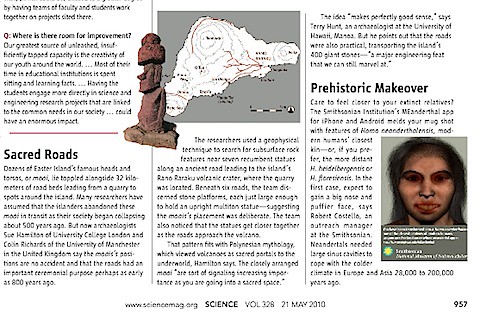A recent news blurb in Science described work by Sue Hamilton and Colin Richards of the University of Manchester that apparent refutes the ideal that the "roads" observed on Rapa Nui are actually related to the statue transport. Their claims are based on (as I understand it -- since there is no actual published article yet, just a press release from their recent season) some geophysical measures made at locations where fallen statues are located along the road. From what I have gleaned, these measurements show evidence of "platforms" that are buried at the position of the bases of statues. The claim made by Hamilton and Richards is that these platforms are evidence that the statues are not evidence of failure during transport, but toppled moai that once lined a processional route that led to the quarry. These routes, they argue, are consistent with a bunch of Polynesian lore in which volcanos are special places.
There are a number of problems with their claims:
(1) They haven't published anything: the Science blurb is based on a press release that they did. Given that these releases are written by PR folks at the university, it is unclear how what they say is related to what archaeological evidence they have, if any. The PR folks are going to make whatever they did into the most sensational story ever -- that's there job. In fact, given that their findings were releases as a press release, I'm fairly shocked that Science even bothered to cover the story -- nothing that they said has been subject to any degree of peer evaluation.
(2) The argument about Polynesian mythology is just made up storytelling. There are lots of Polynesian myths, all of which could be crafted in ways to account for statues arranged in the way they are. Are these positioned to lead people to the ocean? Are they ancestors that over look fields? Are they territorial markers (as argued by Brett Shepardson)? Lots of things are possible and what Hamilton and Richards claim is a heap of mumbo jumbo. This is the worst kind of post-processualism -- empiricist claims interpreted through ad hoc interpretations. Science should be chastised for highlighting this story. In a previous story (in the fall), Hamilton and Richards released a press release about how they found the "pukao" quarry. This press release was equally filled with mumbo jumbo and demonstrated a shocking lack of awareness of the literature.
(3) Statues had to be moved in some way since we know they originated from the quarry at Rano Raraku. This isn't storytelling: we know that they were made at the quarry and we know they were moved. Were they moved down paths other than the ones that they are found?
(4) The statues that are raised on platforms uniformly have eyes carved in them. None of the quarry or "in transit" statues have this feature.
(5) Whatever "platforms" the moai sat on that are found on the roads, these are not ahu - substantial structures built to be the bases for statues. So these "platforms" are just some rocks on which the statue sat - perhaps for stablization during movement?
(6) We don't know where Hamilton and Richards did their geophysical work (i.e., which statues). If the statues are near the quarry, there are other reasons to expect some kind of stablized base having to do with finishing the backs of the statues after sliding them down the slopes of the quarry.
(7) Richards and Hamilton seem to be stuck on the notion that the statues were transported via rollers - and that the "u shape" (noted by Charlie Love previously in excavations) falsifies this transport method (also noted by Charlie Love).
I could go on - but of course lacking an actual publication about the work I'd be speculating what they did and what they found.

No comments:
Post a Comment